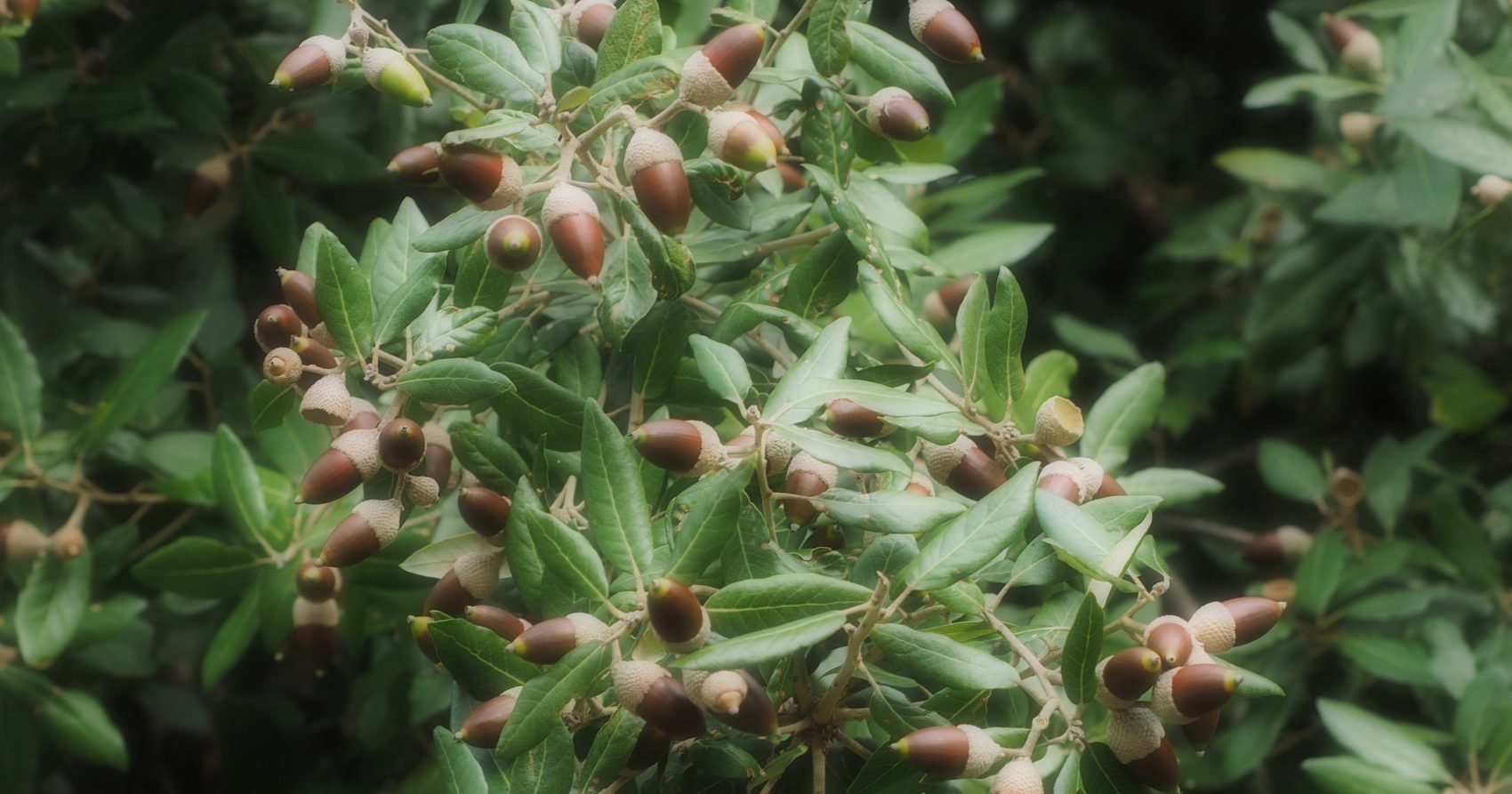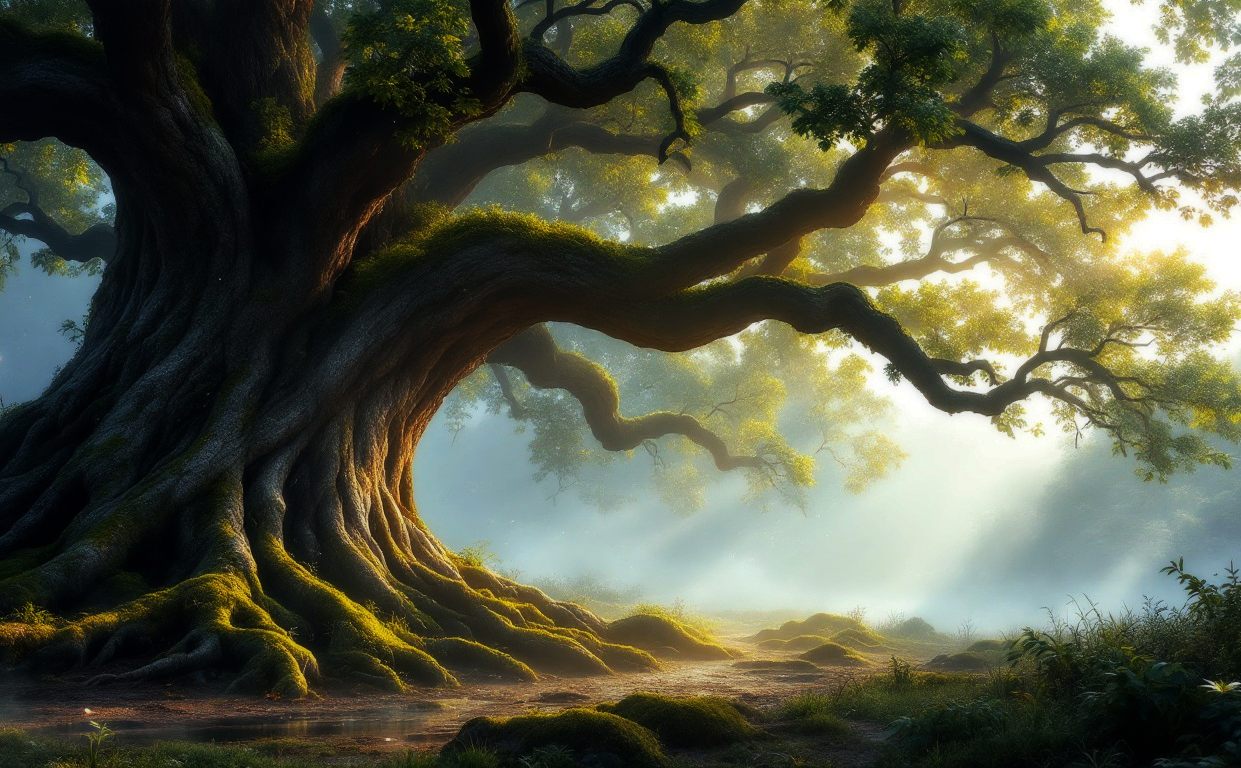Two Hollys and a Myth
Poinsettias graced the Flower Power series last Christmas season. You can read about it by clicking on this link: Poinsettia. Plant life is such a vital and intricate part of all celebrations it is hard to imagine not including their beauty. Another seasonal favorite is English holly with its glossy green leaves and red berries. Not as well known is Holly Oak, another member of Holly’s genus.
Ilex, Holly’s genus name, means “evergreen oak” when translated from Latin:
- (English Holly) Ilex aquifolium originated in Europe, northern Africa and parts of Asia.
- (Holly Oak) Quercus ilex comes from the Mediterranean region of Europe, including the western Himalayas.

English Holly is an evergreen plant which can grow into a tree or be sculpted into hedges. It forms the understory in European forests but since being transplanted to North America its’ ability to reproduce has made it a potential problem. The deep roots quickly snake down, making it a highly durable plant, difficult to eradicate and prone to overtake the environment. Undeniably gorgeous though, English Holly is highly prized for holiday décor and so, after much debate, it is now a permanent resident here in the Pacific Northwest.

Holly Oak is also an evergreen tree which can reach up to 90 feet in height under favorable conditions. Once they are well-rooted, these trees grow and thrive for many centuries. Some Holly Oaks growing today in Spain are well over 1,000 years old. A picturesque silhouette with pendulous low-hanging branches, the Holly Oak gives a glorious regal appearance to any forest.

Both Holly and Holly Oak’s history in ancient celebrations is a long and fascinating one:
In Greek mythology, English Holly was sacred to Cronus and Holly Oak was sacred to Zeus. The ancient Romans associated Holly with Saturn, the god of Agriculture, whose feast day was in the 12th month, December. The Holly (Holm) Oak was associated with Jupiter, the King of the Roman gods, in the 6th month, June.
During the “Golden Age” of Roman mythology, “Saturnalia” was a December festival where people dressed in costumes and wore holly to embody the power of Saturn. December 25, 275 CE the celebration of the Sun gods Mithra, Helio, Apollo and Sol were combined into one known as Sol Invictus (“the Invincible Sun”). By 354, December 25 was officially designated as the birth date of Jesus. In 567 the Saturnalia celebrations became what we now know as “Advent” and wreaths of holly were made to represent the eternal nature of the Divine.
In Northern Europe, where for 12,000 years ancient people constructed solar circles and megalithic structures by which they sought to capture the Sun’s rays on the Winter Solstice, their 12-day celebration came to be called the “Yule tide”. The word Yule is from the old Norse world Hjol which meant “wheel” of the year. It was also the name of the sky father “Odin” or the “Yule One”. Oak was sacred to Odin and it was burned as the Yule log for 12 days to bring luck for the months to come.
*
The intermingling of Holly and Oak from ancient times result in a charming myth of vague origin and countless versions. Here is one version:
The Holly King and the Oak King
Long before humans existed and before the seasons formally divided time into years there were two brothers. One was full of light and in his presence everything grew and blossomed. His crown was made of oak, symbolizing that tree’s nobility, strength and beauty.

His brother was just as good-natured, but he understood the value of dark to balance every light. With the darkness he brought rest and renewal. In his presence the animals would seek their dens and the trees would lose their leaves as the world prepared for the penetrating cold that accompanied his appearance. His crown was made of evergreen holly, a symbol of the sacred circle of life.

Both brothers ruled equally for the most part, living in harmony until there arose a quarrel between them. Some said it was the creation of humans that caused the rift because humans favored the Oak King. They wanted to stay with him because they preferred bright, sunny days, thinking them more valuable than the Holly King’s darkness. As the Oak King grew ever more powerful, the Holly King finally took himself far away.
At first the people were thriving in the light of the endless summer days. As time went on they began to grow weary. The eternal cycle of life and death was broken. Instead of rejoicing in the lush greenery and endless sunshine, it become commonplace, no longer delighting them. The Oak King himself grew weak.
The Holly King knew all of this, even from afar. By the time he returned, the Oak King was too tired to put up a fight and so the Holly King put him into a deep sleep and assumed the kingship. It was not long before the days grew shorter and the cold ensured death and decay as the lands were blanketed with snow. The people and animals were able to rest.
After this, each year when the Holly King is at his dark strongest, at the height of his power on the longest night, the Oak King comes to challenge him, win the crown and gradually allow light to outshine the darkness. Then, each year when the Oak King is at his bright strongest, at the height of his power on the longest day, the Holly King returns to challenge him and win the crown back again and the darkness gradually swallows the light.
And so it is, the wheel of the year is ruled half by the Oak King’s bright light of flourishing fertility and half by the Holly King’s dark time of rest and renewal.
*

In festive celebrations such as Christmas, and others in every culture around the world, we still follow the ancient traditions of celebrating the return of light, of hope, of renewal. Wreaths of holly and the burning of Yuletide oak continue to play an important role in many of these celebrations.

Within the myth of the Holly and Oak Kings strains of ancient voices can be heard, reminding us of the push/pull duality of our world. Before mankind the Kings did not fight for the crown. Those struggles between the Kings came about because of humanity’s preference for light. Within the myth, the Holly King’s actions show the healing power of periods of darkness.

In our daily readings, words of the ancient wise tell us to value the duality by walking a middle road. In our humanity, we celebrate victories such as great athletes who become world champions. That is as it should be. But without the darkness of hours of practice and taking regular periods of rest, that victory would not have been possible.

Our wish for all of us in this festive season is that we, as much as possible, embrace it all, both the light and the dark. In the Northern Hemisphere we’ve come through a period of increasing darkness and, for now, we’re on our way into the light.

